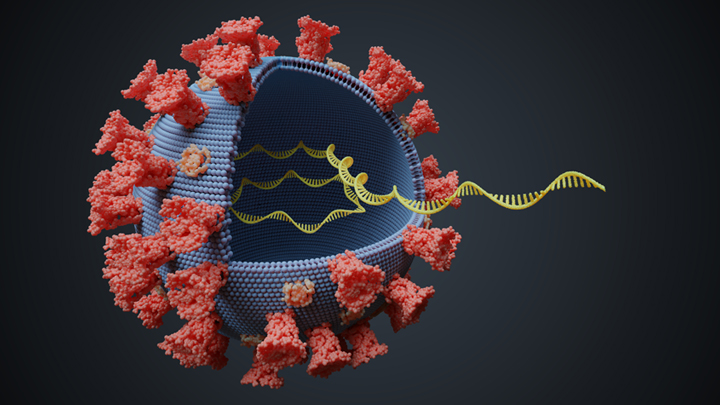

Genome Data Help Track Community Spread of COVID-19
Posted on by Dr. Francis Collins

Contact tracing, a term that’s been in the news lately, is a crucial tool for controlling the spread of SARS-CoV-2, the novel coronavirus that causes COVID-19. It depends on quick, efficient identification of an infected individual, followed by identification of all who’ve recently been in close contact with that person so the contacts can self-quarantine to break the chain of transmission.
Properly carried out, contact tracing can be extremely effective. It can also be extremely challenging when battling a stealth virus like SARS-CoV-2, especially when the virus is spreading rapidly.
But there are some innovative ways to enhance contact tracing. In a new study, published in the journal Nature Medicine, researchers in Australia demonstrate one of them: assembling genomic data about the virus to assist contact tracing efforts. This so-called genomic surveillance builds on the idea that when the virus is passed from person to person over a few months, it can acquire random variations in the sequence of its genetic material. These unique variations serve as distinctive genomic “fingerprints.”
When COVID-19 starts circulating in a community, researchers can fingerprint the genomes of SARS-CoV-2 obtained from newly infected people. This timely information helps to tell whether that particular virus has been spreading locally for a while or has just arrived from another part of the world. It can also show where the viral subtype has been spreading through a community or, best of all, when it has stopped circulating.
The recent study was led by Vitali Sintchenko at the University of Sydney. His team worked in parallel with contact tracers at the Ministry of Health in New South Wales (NSW), Australia’s most populous state, to contain the initial SARS-CoV-2 outbreak from late January through March 2020.
The team performed genomic surveillance, using sequencing data obtained within about five days, to understand local transmission patterns. They also wanted to compare what they learned from genomic surveillance to predictions made by a sophisticated computer model of how the virus might spread amongst Australia’s approximately 24 million citizens.
Of the 1,617 known cases in Sydney over the three-month study period, researchers sequenced viral genomes from 209 (13 percent) of them. By comparing those sequences to others circulating overseas, they found a lot of sequence diversity, indicating that the novel coronavirus had been introduced to Sydney many times from many places all over the world.
They then used the sequencing data to better understand how the virus was spreading through the local community. Their analysis found that the 209 cases under study included 27 distinct genomic fingerprints. Based on the close similarity of their genomic fingerprints, a significant share of the COVID-19 cases appeared to have stemmed from the direct spread of the virus among people in specific places or facilities.
What was most striking was that the genomic evidence helped to provide information that contact tracers otherwise would have lacked. For instance, the genomic data allowed the researchers to identify previously unsuspected links between certain cases of COVID-19. It also helped to confirm other links that were otherwise unclear.
All told, researchers used the genomic evidence to cluster almost 40 percent of COVID-19 cases (81 of 209) for which the community-based data alone couldn’t identify a known contact source for the infection. That included 26 cases in which an individual who’d recently arrived in Australia from overseas spread the infection to others who hadn’t traveled. The genomic information also helped to identify likely sources in the community for another 15 locally acquired cases that weren’t known based on community data.
The researchers compared their genome surveillance data to SARS-CoV-2’s expected spread as modeled in a computer simulation based on travel to and from Australia over the time period in question. Because the study involved just 13 percent of all known COVID-19 cases in Sydney between late January through March, it’s not surprising that the genomic data presents an incomplete picture, detecting only a portion of the possible chains of transmission expected in the simulation model.
Nevertheless, the findings demonstrate the value of genomic data for tracking the virus and pinpointing exactly where in the community it is spreading. This can help to fill in important gaps in the community-based data that contact tracers often use. Even more exciting, by combining traditional contact tracing, genomic surveillance, and mathematical modeling with other emerging tools at our disposal, it may be possible to get a clearer picture of the movement of SARS-CoV-2 and put more targeted public health measures in place to slow and eventually stop its deadly spread.
Reference:
[1] Revealing COVID-19 transmission in Australia by SARS-CoV-2 genome sequencing and agent-based modeling. Rockett RJ, Arnott A, Lam C, et al. Nat Med. 2020 July 9. [Published online ahead of print]
Links:
Coronavirus (COVID-19) (NIH)
Vitali Sintchenko (University of Sydney, Australia)






















.png)











No hay comentarios:
Publicar un comentario